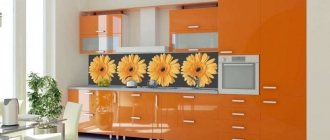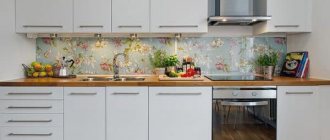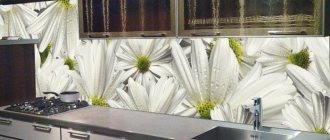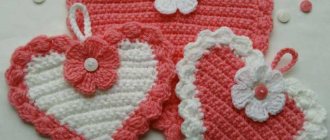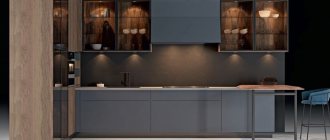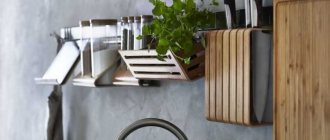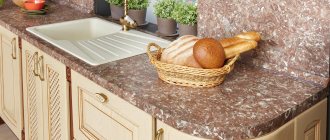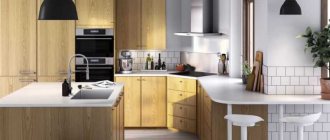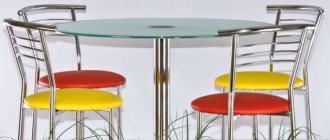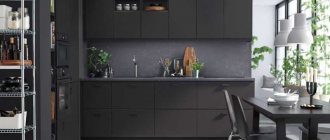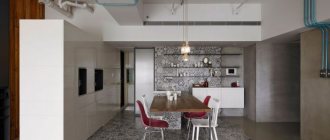A false panel is best suited for the kitchen. Usually, during renovation, places may appear that will not be required for further use, but still need decoration. Then false panels will come to the rescue. This type of decoration is used as a kitchen apron, which will save your time and money, because these panels are made from different finishing materials that meet certain requirements.
What is a false panel: materials of manufacture
A false panel is a decorative plate that can be made from various materials. In terms of their texture and shades, false panels for the kitchen are no different from ordinary wall decoration.
Are fittings or pipe remains sticking out of the wall? The fittings will help you hide all the imperfections
Purposes of false panels:
- Leveling surfaces;
- Masking of any defects on the walls, as well as various voids and large cracks;
- Improvement of unsightly areas between adjacent cabinets;
- Masking of pipes and electrical wiring;
- Participation in lighting design.
Materials for false panels:
- Natural wood. The most environmentally friendly material that can be used in decorating a kitchen in a classic or country style. The disadvantage of the material is the high cost and fear of high humidity.
- Chipboard. One of the most popular materials in use. It has a wide selection of colors, reasonable prices and good moisture resistance. The installation of such panels is quite simple; you can do the installation yourself.
- PVC. The most practical material, famous for its fireproof and waterproof qualities. Dirt practically does not accumulate on the smooth surface, which is suitable for decoration anywhere in the kitchen. The material has a relatively low cost and has a wide selection of colors, which is an ideal option for kitchen installation.
- Stone. False panels decorated with stone are used for spacious rooms with a rich interior. Such material will not cost you cheap and is usually installed in certain areas of the kitchen. However, artificial or natural stones give the room both coziness and luxury, which is perfect for a modern kitchen.
Related article: Interior doors with patina in a modern interior
The most versatile option is a false chipboard panel: it will fit into any design style
In addition to basic materials, many designers use plexiglass, metal mosaics or mirror elements to decorate false panels. But for such decorations, a strong and high-quality base must first be installed. The scope of application of such panels is practically unlimited; they can be used anywhere and for any purpose, as long as the material allows it.
How to make it yourself
To make a false panel for the kitchen yourself, you need to carry out the whole process in several stages:
- A plastic profile in the shape of the letter P is measured around the perimeter, forming the contours of the false panel, but is not fixed to the wall. To make the final result look aesthetically pleasing, you need to trim the corners of the profile by 45 degrees.
- Plastic panels are cut into the required lengths and then inserted into the starting strip. When all the parts are secured, it is necessary to install the main profile on a vertical surface.
- The lower joint of the panel with the countertop is first sealed. Before installing the starting profile, you need to apply silicone to the profile or countertop.
- If you need to install it on a wooden base, you must use self-tapping screws. For a base made of concrete or cement, it is necessary to use silicone surface fastening, since making holes is impractical.
How to install and how to fasten a wall false opening
False panels are attached in different ways depending on their desired location:
- in the upper part of the kitchen walls they are located under wall cabinets;
- when located at the level of the lower part of the kitchen unit, they are installed behind the baseboard.
Work order:
- the required distance for the panel is measured taking into account small facing panels that give the structure a finished look;
- using a building level, you can measure the accuracy of the fastening;
- the pre-assembled panel is brought to the mounting location for marking;
- a core drill suitable for the diameter of the fastening elements is selected and markings are made;
- a false panel is applied and fastened in the corners or along the perimeter;
- to close the joints, a connecting strip is used;
- the built-in panel must be completely covered with these strips. At corners, 90-degree beveled parts should be used.
- 50 – 100 mm;
- 500 – 1300 mm;
- 1000 – 4100 mm.
Your repost will change the Internet
Modern finishing materials offer many interesting solutions that allow you to quickly and inexpensively change the design or hide certain flaws in the interior. Separately, it is worth highlighting the false panel for the kitchen. Decorating a room with such material allows you not only to hide unevenness or hide communications, but also to make a bright accent. The decorative possibilities of false panels are almost limitless. The most popular among buyers are options with photo printing or with imitation of natural materials, such as wood, concrete or stone.
What it is?
A decorative finishing board is commonly called a false panel. It can not only effectively decorate the interior, but also hide the shortcomings of the room.
It is often chosen as an apron. It can be based on decorative sheets made from laminated chipboard, less often from MDF, in which one side has a beautiful design.
Experts recommend installing false panels when the need arises:
- replace the old kitchen apron with a new one;
- disguise the corrugation from the hood;
- close communications, niches, defects, irregularities;
- cover furniture legs;
- close the gaps formed between the wall and the cabinets;
- create conditions for decorative lighting;
- give the walls a flat surface.
The photo below shows an example of corrugation camouflage:
And in the other photo below is the wood-look finish of the MDF apron.
Finishing with decorative slabs to imitate concrete walls:
What materials are they made from?
The following types of panels are used for the kitchen.
- Wooden. Since wood can lose its attractive appearance due to frequent cleaning and humidity, it is better to use wax-coated MDF boards for the apron.
- Chipboard and MDF. Panels made of this material allow you to make any design or pattern that is applied using photo printing. The length of the service life depends on the strength of the protective layer of laminated chipboard or MDF. The most durable sheets are those coated with acrylic or varnish.
- Glass. They demonstrate the highest practicality and moisture resistance. Glass panels are made from triplex, silicate, tempered, acrylic and polycarbonate glass. The decoration can be decorated with patterns made using sandblasting or photo printing.
- Plastic. They attract with their practicality, moisture resistance, the ability to imitate any material (brick, wood, stone) and low price. You can also use panels with double-sided finishing, which will allow you to replace the boring pattern with a new one over time.
- Metal. For a kitchen apron, it is best to use stainless steel with a matte finish. Most often, this finishing is used in the area close to the slab.
- Fake diamond. Monolithic panels allow you to create a surface without a single seam. In case of damage (chips, scratches), acrylic stone can be restored.
- Ceramic. They provide for preliminary gluing of ceramic tiles to plywood, after which the sheets are attached to the wall. This option allows you to remove the tiles without damage.
How to attach to walls?
The installation of false panels in the kitchen work area is usually performed permanently. But it is possible to install the finishing material so that the masked panel can be removed from the problem area and put back in place. The process of installing finishing panels can be carried out in several ways. Finishing panels can be mounted on:
- wood sheathing. Bars with a rectangular cross-section are placed vertically in increments of 0.5 m and secured with screws.
- metal profile. This type of lathing is beneficial for kitchens with high humidity and uneven walls.
- staples. In this case, simple construction staples are used to install the panels.
- glue. In this case, installation will require carefully leveling the walls, applying a primer and drying.
See the adhesive mounting option in the following video:
Practical recommendations: how to install a false panel in the kitchen
Few people know how to attach a false panel in the kitchen, but we can assure you that it is easy and simple - even a non-professional can do it. The most important advantage is that they are easy to wash, easy to care for and have a fairly long service life.
Tools required for work:
- Roulette;
- Hammer;
- Dowels;
- Self-tapping screws;
- Drill;
- Galvanized sheets;
- Level.
Installation of the false panel must be done before installing the fittings
Recommendations for attaching false panels:
- The width of the slab used to mount the kitchen apron should be from 4 to 10 mm.
- The film that covers the “apron” slab should have the same color scheme and pattern as the countertop.
- Wall panels are fastened to the wall using liquid nails.
- You can also fasten it with dowel nails. To do this, you need to select their appropriate sizes, and then hide them using caps that match the color of the panel.
Preparatory stage for installation:
- At the beginning of work, it is necessary to carefully measure the kitchen in order to determine the exact number of panels required.
- Then you need to purchase the necessary fittings - corners, profiles with which the panels will be attached. This is done in doorways and corners of the kitchen.
- Before starting work, we advise you to leave the panels in the room for about ten hours so that they adapt to the temperature conditions. Next, you need to unpack them and prepare wooden slats for the sheathing frame. The slats are fastened with self-tapping screws and dowels, the gap between them is about fifty centimeters wide.
- It is better to fasten the slats in a horizontal position so that they are parallel to the floor. If the facing panels are mounted vertically, then the batten sheathing must be installed vertically. The principle of fastening must be observed in that the sheathing must always be perpendicular to the panels.
- To protect PVC panels from the harmful effects of moisture, they should be protected with special impregnation. This must be done before attaching them to the frame. And then carry out the subsequent installation of corner profiles.
Related article: Do-it-yourself doors. Manufacturing of doors for outbuildings
Before installing the false panel, it is worth plastering and leveling the wall
After all the preparatory stages have been completed, you can safely begin installing the false panels. You should start the following work from the left corner, moving towards the window or doorway.
Functionality of false panels
False panels for the kitchen are used not only in the area of the working wall between the table and wall cabinets. The photos of finished kitchens show that such finishing helps in masking various defects in walls and niches, even down to voids in which communications can be hidden.
Effectively concealed base legs
With the help of such plates, supports and fasteners are covered, which can spoil the overall appearance of the furniture. For example, the space from the floor to the lower cabinet can be covered with one panel, which is attached with special clamps to the legs of the set. Is this part removed if necessary? for cleaning or access to the lower part of the furniture and to the communications passing under it.
Methods for installing false panels in the kitchen
Installing false panels in the kitchen is quite easy to do with your own hands. You just need to carefully prepare for installation and follow simple rules.
The advantage of liquid nails is that the end result will be neat, without protruding nails or screws
Methods for installing false panels for the kitchen:
- Installation on a wooden sheathing. This installation is best done on flat wall surfaces, where humidity values are at optimal levels. The sheathing is made from rectangular bars, which are placed vertically, parallel to each other at a distance of half a meter and then secured with screws. Be sure to use a level when installing wooden sheathing to avoid distortions.
- Fastening to a metal profile. If the room has uneven walls or high humidity, then it would be preferable to use mounting profiles. They are attached to metal slats previously installed on the wall, which corrects unevenness and does not require additional leveling of the walls with plaster. And in case of dampness, the metal profile will not warp.
- Installation using building brackets. One of the simplest installations is when, when decorating walls, ordinary building staples are used, but only if they allow the configuration of the grooves.
- Fastening with liquid nails. This installation of facing panels is the simplest, which anyone can handle. It is necessary that before this the surfaces of the walls are thoroughly cleaned, leveled, primed and well dried. Then you will not need to make sheathing or purchase staples for sheathing.
Each installation method has its own advantages under certain conditions. The main task will be the aesthetic and harmonious design of the kitchen interior. If you can combine several qualities at once - practicality, efficiency, cost-effectiveness and excellent decoration, then your kitchen will be in an advantageous position.
Related article: How to choose metal-plastic windows: expert advice
Advice from experts
To prevent the purchased panel from cracking or deforming during the first year of use, you need to purchase products from well-established manufacturers. In addition, experts advise when choosing to pay attention to the nuances:
- when installing a bright false panel, the rest of the design becomes more restrained, and vice versa;
- On a light or plain surface, dirt is more noticeable than on multi-colored and variegated surfaces, so it will have to be washed more often;
- light glossy products visually increase the size of the room, while matte ones reduce them;
- If the accent of the kitchen is a panel with a 3D pattern, you will have to abandon the bright decor so that it does not distract attention.
Examples of false panels for the kitchen (photo)
Fastening the apron with dowels and screws
Fastening an MDF apron in the kitchen with self-tapping screws or mounting dowels is done as follows.
- First, holes are marked on the panel blank and holes are drilled for the inserts of the decorative caps.
- Then, having positioned the panel at the installation site, mark the marks of the holes for the nylon dowels. This method will avoid displacement of the holes.
- Having removed the panel, drill technological holes and then install nylon dowels.
Installing a decorative cap
The panel is secured with self-tapping screws or screws through inserts onto which decorative chrome caps are screwed onto threads. Of course, this fastening method requires accuracy and more time, but in the future, if necessary, it allows you to quickly replace partially or completely the wall elements of the kitchen apron.
Required tool:
- Metric tape measure.
- Pencil.
- Screwdriver.
- Drill.
- Hammer.
A set of fasteners for attaching an MDF apron in the kitchen
First, a plastic dowel is installed in the technological hole flush with the wall surface, then a brass bushing with a silicone damper is put on, and secured with a self-tapping screw. The last thing to install is the chrome decorative cap.
Kitchen apron made of MDF, secured with dowels
Natural wood
Basically, the raw materials for such models are the following types of wood:
Natural wood - beautiful and practical, but a little expensive
This option is the cleanest in environmental terms, but it is expensive and is afraid of high humidity. To increase moisture resistance, such panels are rubbed with wax.
You won’t find particularly flattering reviews of this material anywhere, and there are many reasons for this:
- low strength;
- tendency to destruction from temperature changes and high humidity.
These are the main reasons, which are more than compelling, because a kitchen is a kitchen - and such factors are not uncommon. Nevertheless, the material is very common due to its low cost and richness of color options.
In addition, you won’t have to rack your brains too much - how to install a false panel in the kitchen with your own hands - it’s very simple in this case.
Installation
Before you add a false panel to your kitchen, you need to choose the appropriate option. In this matter, you need to focus not only on your own preferences, but also on operating conditions. If you need a durable and reliable surface, it is best to look at quality materials. A good choice for creating a finish would be glass or solid wood.
During the purchasing process, you need to find out about the presence of fireproof properties of materials, as this is important during operation.
To finish the apron, you need to use moisture-resistant types that are not afraid of exposure to high temperatures. If you choose a material solely for decorative purposes, you can use a wide variety of options. Fire-resistant panels are suitable for hiding communications.
After choosing the material, you need to decide on the size of the finish. It is best to do this before purchasing panels, having previously measured the parameters, which will facilitate the selection process.
After purchasing the appropriate option, you can begin installation.
You can install the false panel yourself, without turning to a specialist for help. The main thing that is required of you in this case is to follow the step-by-step process. First you need to eliminate the defects that have formed on the wall. This applies to various irregularities and crevices that appeared during operation. It is best to attach false panels before placing kitchen furniture. This is especially true for various hanging structures.
Plastic lamination
For the kitchen, laminated wall planks with a decorative plastic layer are often chosen. Instead of paper film, there is a polymer PVC coating on top of the surface. You can create plain glossy surfaces, leather texture, imitation of mosaic masonry or the structure of any wood and natural stone. Coatings that imitate metal are popular: nickel, textured aluminum, chrome.
A wide selection of sizes allows installation in horizontal and vertical directions. They even install the tabletop from this material so that it matches the apron.
Kitchens where all the walls are decorated with panels look beautiful. But here you need to create a metal frame, since this is a large load on the walls. The sheets can be easily removed if necessary.
Design selection
The approach to designing a false panel can be different. If you want to make it a key element of your kitchen decor, then you can use the most spectacular 3D print and spot LED lighting. If you want to hide the panel, it is decorated in a discreet color scheme, for example, to match the rest of the walls.
You should not skimp on the quality of the panel if expensive furniture and appliances are already installed in the kitchen. The contrast will be too noticeable and will spoil the entire impression of the renovation.
Very bright and elegant
